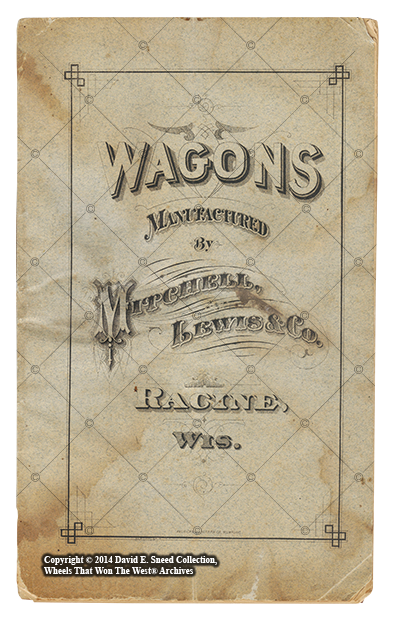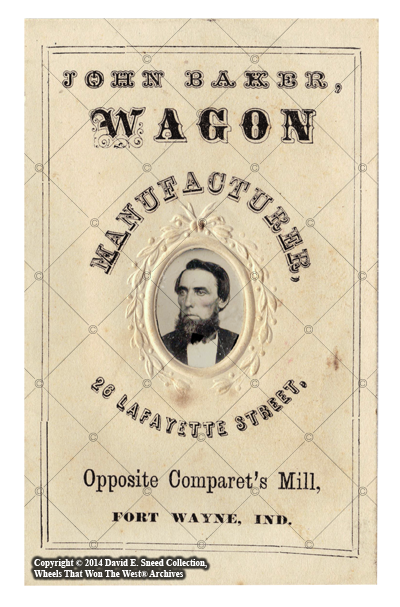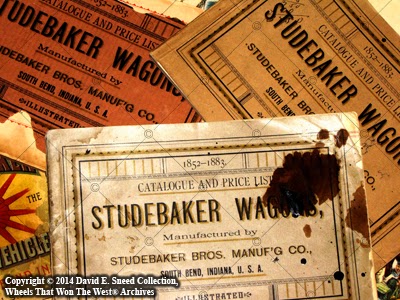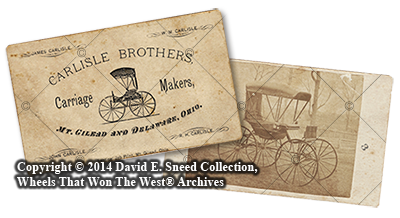Every set of wooden wheels has a story to tell - make that, lots of stories to tell. From who owned it and where it's traveled to who made it, for what purpose, and how was it done, there is a tremendous amount of history attached to any early horse drawn vehicle. Unfortunately, much of this provenance often goes overlooked and unknown. It's just the kind of mysteries that get my full attention. After all, some of the more noteworthy findings today will be directly related to America's most legendary western transportation giants. Ultimately, it's why we do what we do; constantly digging, searching, combing, and pouring over virtually every facet of this subject. It's a passion fraught with challenges. Nonetheless, over the last two decades, our efforts have been rewarded by the consistent uncovering of volumes of new information. The process has also allowed us to locate, identify, and help preserve a number of historic and previously lost 19th century vehicles.
One of the greatest assets in our search for America's wheeled past is the broad scope of period sales literature in the Wheels That Won The West Archives®. With original materials in the collection dating from the early 1800s and extending through the 1960s, scouring those pages of history has helped us authenticate countless brands. That said, the majority of the earliest industry catalogs were created for a small number of company representatives and, as such, there are few survivors today. It's a shame as these elements not only offer an authoritative view of design standards but, in many cases, they serve as the only source from which we can learn more from a particular manufacturer.
 |
| This 1875 catalog may hold the only surviving specifications for legendary Mitchell wagons (Racine, WI) produced during this era. |
Pre-Civil War catalogs profiling wagons and coaches are particularly difficult to come by because so few builders could afford the labor intensive costs of printing bound matter in those days. As a result, the majority of all vehicle information prior to the Civil War is typically limited to faded and worn business ledgers, newspapers, letters, trade journals, directories, guides, universal print blocks, or some other mass produced work.

This 1860s wagon maker tintype is part of an extremely scarce early business card.
As the decades passed after the War, promotional printing became more common. In fact, by the 1880s, larger vehicle makers were regularly engaged inthe printing of sales cards, calendars, catalogs, flyers, leaflets, and other materials. Some pieces were still produced strictly for dealers while others were intended for the end user. Larger 19th century firms like Milburn, Jackson, and Studebaker worked especially hard to flood the market with up-to-date literature. So prevalent was this focus that Studebaker is known to have reprinted multiple versions of the same catalog during the same year.1

1883 Studebaker Wagon Catalogs
Our commitment to locating these early pieces has led us to countless rare discoveries - including what is likely the earliest surviving flyer and illustration promoting the legendary Bain wagon (1869). Our archives also house several thick, hardcover maker catalogs including a pair from 1860 and 1862. Likewise, years ago, we happened upon a one-of-a-kind image of a Moline wagon from 1870 (just one year after the company started in Moline, Illinois). Other 1870s information from Studebaker, Peter Schuttler, Mitchell, Milburn, Jackson, and the Kansas Wagon Company top the list of primary source literature we've preserved from this decade. Additional 1880s and 1890s pieces in the collection include the vast majority of the most dominant wagon and western vehicle builders as well as a host of smaller firms. Collectively and individually, these materials have helped piece together a myriad of stories that continue to shed light on surviving vehicles. In fact, the combined body of materials has not only helped us outline when certain technologies and designs were being utilized but, as I've already mentioned, the literature provides an invaluable resource, helping to identify significant brands, histories, and values.

This rare business card from an Ohio maker dates to around 1873 and includes an extremely scarce product photo on the back.
As we continue in our search for America's rarest wheeled history, from time to time, we'll share more about the discoveries. Reinforcing this week's discussion on the importance of early period literature, we recently identified the maker of an 1870s-era spring seat as Studebaker. The seat still holds the majority of its original paint and artistic striping.2 Through extensive reviews of same-period imagery, we've come to a supportable conclusion that - during this particular timeframe - brand logos were not always included on the seats. As time progressed, maker logos became more prevalent on seat backs. Piece by piece, these extraordinary findings continue to shed even more light on how every part of America's early western vehicles were designed. Likewise, each discovery allows us to more easily recognize and rescue valuable parts of America's frontier past... before they're lost forever.
1 The Wheels That Won The West® Archives include multiple Studebaker vehicle catalogs from 1883. While each book is labeled the same with most pages being exact duplicates, there are slight color variations in the outside cover and, when comparing the books to each other, some vehicles have been updated, added, or eliminated.
2 In 20 years of pursuit, this spring seat is only the second that we have identified as being built by a specific maker during the 1870s. Both seats were authenticated using early Studebaker literature and available imagery as a part of the evaluation process.